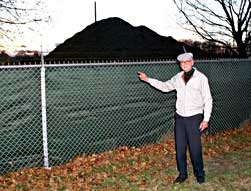| --------------------e-mail letter August 14,
1998------------------
Dear Hans: The 14.4 ppm uranium in the dust sample from
the
If you have the funds, it would be advisable
to send a portion
My paper at the WISE site is the same
paper that is published in
Regards, --------------------e-mail letter August 15, 1998------------------ To: Hans de Jonge, Dear Hans:
Congratulations, you have hit the jackpot!
The uranium analysis results
I did a simple analysis of the U-235/U-238
isotope ratio equals 0.0024.
Rest assured, I will treat your data in strictest
confidence until after you
Let me show you how I analyzed your data. The
technique may help you
Natural uranium is ubiquitous in nature. I
may have mentioned to you
Let T= 13.2 mg/kg be the total amount of uranium
measured per kilogram of dust.
We now form a ratio expression for U-235/U-238
in the observed dust sample and
Substituting the known values for the individual
constants and solving the equation
From Table I of my paper we see that the U-238/U-235
ratio for DU is
You now have some very powerful and convincing
data. A point that you and your
Except for uranium mines, natural uranium always
occurs in highly dilute
I suggest that you ask the laboratories for
their measurement errors, as
I greatly appreciate your keeping me informed
and will continue to
Best regards, Len
Dietz
---------------------e-mail letter August 16,
1998------------------
To: Hans de Jonge, Dear Hans:
As follow-up to the e-mail letter I sent you
yesterday, let me make
You now know that most of the uranium in your
hangar dust sample is DU.
I believe you told me earlier that approximately
100 people who have been
I am enclosing a USA Today newspaper article
that reports new genetic
I hope this additional information is useful
to you and your colleagues.
Best regards, Len
Dietz
-------------------------------------
Received from Dr. Ross Wilcock by Len Dietz
on May 27, 1998
This is by no means new. Rosalie Bertell described
this kind of
Ross Wilcock,
-----Original Message-----
From: owner-abolition-caucus@igc.org
Subject: Fwd: New radiological damage process
being found----the
Hello NukeNet,
The topic of radiological or toxic DNA damages
are closely related.
There are these type problems long before cancers
form due to
Sincerely,
Jim Phelps, Env. News, http://members.aol.com/doewatch
---------------------------
USA Today News
Genetic researchers say they have made progress
in human
California scientist Howard Urnovitz will contend
today at the
Urnovitz told Gannett News Service that the
chromosome damage
About one-seventh of American troops in the
Gulf War-more than
Urnovitz is the science director for two organizations,
the nonprofit
Urnovitz believes the nucleic acids that normally
do this somehow reinsert
His hypothesis:
Urnovitz also thinks his research may provide
insight into some mysterious
James Tuite III, a director of the Chronic
Illness Research Foundation
-------------------END of August 16th e-mail
letter------------------------
|
